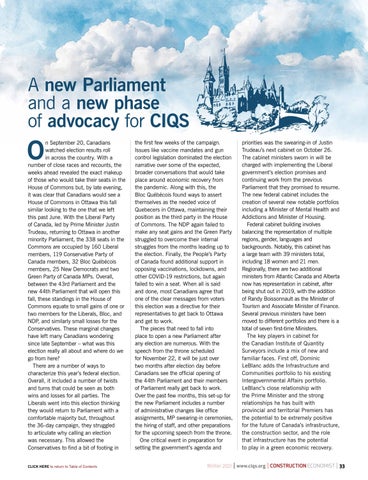A new Parliament and a new phase of advocacy for CIQS
O
n September 20, Canadians watched election results roll in across the country. With a number of close races and recounts, the weeks ahead revealed the exact makeup of those who would take their seats in the House of Commons but, by late evening, it was clear that Canadians would see a House of Commons in Ottawa this fall similar looking to the one that we left this past June. With the Liberal Party of Canada, led by Prime Minister Justin Trudeau, returning to Ottawa in another minority Parliament, the 338 seats in the Commons are occupied by 160 Liberal members, 119 Conservative Party of Canada members, 32 Bloc Québécois members, 25 New Democrats and two Green Party of Canada MPs. Overall, between the 43rd Parliament and the new 44th Parliament that will open this fall, these standings in the House of Commons equate to small gains of one or two members for the Liberals, Bloc, and NDP, and similarly small losses for the Conservatives. These marginal changes have left many Canadians wondering since late September – what was this election really all about and where do we go from here? There are a number of ways to characterize this year’s federal election. Overall, it included a number of twists and turns that could be seen as both wins and losses for all parties. The Liberals went into this election thinking they would return to Parliament with a comfortable majority but, throughout the 36-day campaign, they struggled to articulate why calling an election was necessary. This allowed the Conservatives to find a bit of footing in CLICK HERE to return to Table of Contents
the first few weeks of the campaign. Issues like vaccine mandates and gun control legislation dominated the election narrative over some of the expected, broader conversations that would take place around economic recovery from the pandemic. Along with this, the Bloc Québécois found ways to assert themselves as the needed voice of Quebecers in Ottawa, maintaining their position as the third party in the House of Commons. The NDP again failed to make any seat gains and the Green Party struggled to overcome their internal struggles from the months leading up to the election. Finally, the People’s Party of Canada found additional support in opposing vaccinations, lockdowns, and other COVID-19 restrictions, but again failed to win a seat. When all is said and done, most Canadians agree that one of the clear messages from voters this election was a directive for their representatives to get back to Ottawa and get to work. The pieces that need to fall into place to open a new Parliament after any election are numerous. With the speech from the throne scheduled for November 22, it will be just over two months after election day before Canadians see the official opening of the 44th Parliament and their members of Parliament really get back to work. Over the past few months, this set-up for the new Parliament includes a number of administrative changes like office assignments, MP swearing-in ceremonies, the hiring of staff, and other preparations for the upcoming speech from the throne. One critical event in preparation for setting the government’s agenda and
priorities was the swearing-in of Justin Trudeau’s next cabinet on October 26. The cabinet ministers sworn in will be charged with implementing the Liberal government’s election promises and continuing work from the previous Parliament that they promised to resume. The new federal cabinet includes the creation of several new notable portfolios including a Minister of Mental Health and Addictions and Minister of Housing. Federal cabinet building involves balancing the representation of multiple regions, gender, languages and backgrounds. Notably, this cabinet has a large team with 39 ministers total, including 18 women and 21 men. Regionally, there are two additional ministers from Atlantic Canada and Alberta now has representation in cabinet, after being shut out in 2019, with the addition of Randy Boissonnault as the Minister of Tourism and Associate Minister of Finance. Several previous ministers have been moved to different portfolios and there is a total of seven first-time Ministers. The key players in cabinet for the Canadian Institute of Quantity Surveyors include a mix of new and familiar faces. First off, Dominic LeBlanc adds the Infrastructure and Communities portfolio to his existing Intergovernmental Affairs portfolio. LeBlanc’s close relationship with the Prime Minister and the strong relationships he has built with provincial and territorial Premiers has the potential to be extremely positive for the future of Canada’s infrastructure, the construction sector, and the role that infrastructure has the potential to play in a green economic recovery.
Winter 2021 | www.ciqs.org | CONSTRUCTION ECONOMIST | 33







